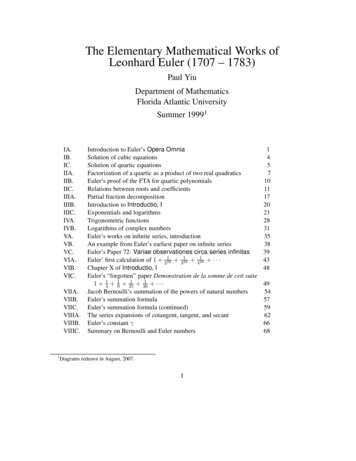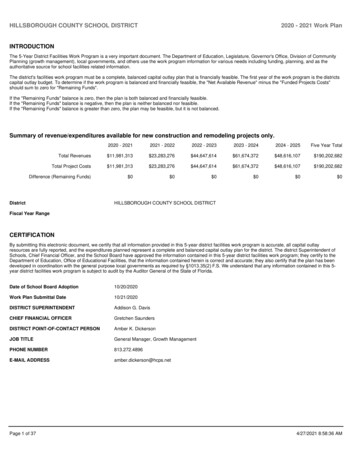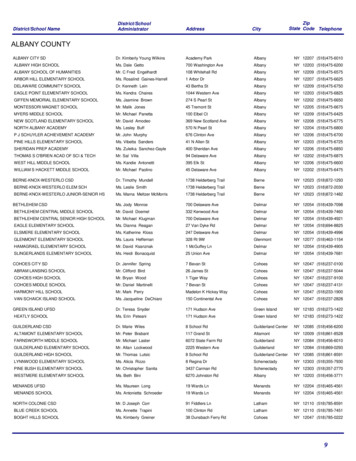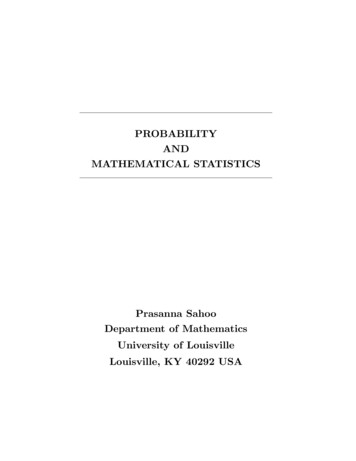
Transcription
The Elementary Mathematical Works ofLeonhard Euler (1707 – 1783)Paul YiuDepartment of MathematicsFlorida Atlantic UniversitySummer IC.1Introduction to Euler’s Opera OmniaSolution of cubic equationsSolution of quartic equationsFactorization of a quartic as a product of two real quadraticsEuler’s proof of the FTA for quartic polynomialsRelations between roots and coefficientsPartial fraction decompositionIntroduction to Introductio, IExponentials and logarithmsTrigonometric functionsLogarithms of complex numbersEuler’s works on infinite series, introductionAn example from Euler’s earliest paper on infinite seriesEuler’s Paper 72: Variae observationes circa series infinitasEuler’ first calculation of 1 212k 312k 412k · · ·Chapter X of Introductio, IEuler’s “forgotten” paper Demonstration de la somme de cett suite11 36 ···1 14 19 25Jacob Bernoulli’s summation of the powers of natural numbersEuler’s summation formulaEuler’s summation formula (continued)The series expansions of cotangent, tangent, and secantEuler’s constant γSummary on Bernoulli and Euler numbersDiagrams redrawn in August, 2007.I145710111720212831353839434849545759626668
IB.XVIC.Continued fractionsContinued fractions and infinite seriesContinued fraction expansion of functionsEuler’s proof of Heron’s formulaArea of a cyclic quadrilateralThe excircles and Heron’s formulaTriangle centersDistances between various centersThe nine-point circle and Feuerbach’s theoremEuler’s construction of a triangle with given circumcenter,incenter, and orthocenterSpecial casesConstructionsEuler and the Fermat numbersPerfect numbers and Mersenne primesEuler’s proof of Fermat’s little theoremEuler’s Tractatus de numerorum doctrinaEuler’s extraordinary relation involving sums of divisorsEuler’s pentagonal number theoremThe Pell equationEuler’s proof of Fermat’s last theorem for n 4Sums of two squaresEuler’s proof of Fermat’s last theorem for n 3Sums of fourth powersOn Euler’s fearsome foursomeFurther ReadingExercises and 11411812112212412512913423 pages
YIU: Elementary Mathematical Works of Euler1The Elementary Mathematical Works ofLeonhard Euler (1707 – 1783)Paul YiuDepartment of MathematicsFlorida Atlantic UniversitySummer 1999IA. IntroductionEuler’s Opera OmniaSeriesIIIIIIIV AIV BSubjectPure MathematicsMechanics andAstronomyPhysics 9Pages13979Complete3111007v.26,27 to appear128432518118031122v.10 to appearv.3,4,7,8 to appearIn progress7 volumesSeries I – Pure MathematicsSubjectNumber TheoryAlgebraCombinatoricsInfinite SeriesIntegratonElliptic IntegralsDifferential EquationsCalculus of 3979
YIU: Elementary Mathematical Works of EulerEuler: Opera OmniaSeries I – Pure 319361938195219521953195419551956ContentElements of Algebra, 1770Number TheoryNumber TheoryNumber TheoryNumber TheoryTheory of EquationsCombinatorics and ProbabilityIntroductio in Analysin Infinitorum, I, 1748Introductio in Analysin Infinitorum, II, 1748Differential Calculus,1755Integral Calculus, 1768Integral Calculus, 1768Integral Calculus, 1768Infinite SeriesInfinite SeriesInfinite SeriesInfinite SeriesIntegrationIntegrationIntegrationElliptic IntegralsElliptic IntegralsDifferential EquationsDifferential EquationsCalculus of Variations, 1744Calculus of VariationsGeometryGeometryGeometryGeometry2
YIU: Elementary Mathematical Works of Euler3Euler’s Elements of Algebra (1770)ContentsPart I: Containing in Analysis of Determinate Quantities.Section I. Of the different methods of calculating simple quantities. (23 chapters; 75 pages) Of impossible, or imaginary quantities, which arise from the same source. 2Section II. Of the different methods of calculating compound quantities. (13 chapters; 50 pages) Chapter IV. Of the summation of arithmetical progressions. Chapter VII. Of the greatest common divisor of two given numbers. Chapter XI. Of geometrical progressions.Section III. Of ratios and proportions (13 chapters; 60 pages)Section IV. Of Algebraic equations, and of the resolution of those equations. (16 chapters; 113 pages) Chapter IX. Of the nature of equations of the second degree. Chapter X to XII. Cubic equations; of the rule of Cardan, Or of Scipio Ferreo. Chapter XIII to XV. Equations of fourth degree. Chapter XV. Of a new method of resolving equations of the fourth degree.Part II: Containing the Analysis of Indeterminate Quantities. (15 chapters; 164 pages)Elementary number theory up to the solution of quadratic equations in integers.Additions by Lagrange (9 chapters; 131 pages)Sample exercises in Elements of Algebra2Every body makes mistakes, even the masters. Here is an observation by Ivor Grattin - Guinness The Norton History ofMathematical Sciences, The Rainbow of Mathematics, 1997, [W.W.Norton & Company, New York, pp. 334 – 335]. on Euler’sElements of Algebra:As usual, Euler gave a reliable presentation; but he gaffed in his algebraic handling of complex numbers, bymisapplying the product rule for square roots ab a b,to write 2 3 6 instead of 6.[Art. 148, 149] The error was systematic: for example, he committed it for division as well, and it confused somelater writers on the subject.
YIU: Elementary Mathematical Works of Euler4Section II, Chapter IV.1. Required the sum of an increasing arithmetical progression, having 3 for its first term, 2 for thecommon difference, and the number of terms 20.(Answer: 440).4. One hundred stones being placed on the ground, in a straight line, at the distance of a yard fromeach other, how far will a person travel who shall bring them one by one to a basket, which is placed oneyard from the first stone?(Answer: 5 miles and 1300 yards).Section II, Chapter VII: On finding the gcd of two numbers.Divide the greater of the two numbers by the less; next, divide the preceding divisor bythe remainder; what remains in this second division will afterwards become a divisor fora division, in which the remainder of the preceding divisor will be the dividend. we mustcontinue this operation till we arrive at a division that leaves no remainder; and this lastdivisor will be the greatest common divisor of the two given numbers.Examples: Find the gcd of (i) 252 and 576; (ii) 312 and 504; (iii) 529 and 625; (iv) 1728 and 2304.IB. Solution of cubic equationsEuler’s Paper 30: De formis radicum aqequationum cuiusque ordinis coniectatio (1732/33) 1738.§3. Resolutionem aequationis cubicae sequenti modo a quadratic pendentm considero. Sitaequation cubicax3 ax bin qua secunda terminus deest; huis radicem x dico fore 33 A Bexistentibus A et B duabus radicibus aequationes cuiusdam quadraticaez 2 αz β.Quamobrem ex natura aequationum eritA B α etAB β.Sed ad α et β ex a et b definiendas sumo aequationem 33x A B,quae cubice multiplicata dat 333x3 A B 3 AB( A B)
YIU: Elementary Mathematical Works of Euler5 3 3x AB A B.Quae cum proposita x 3 ax b comparata dabit 3a 3 AB 3 3 β etb A B α.Fiet igiturα betβ a3.27Huis enim radicibus cognitis A et B eritx 33A B.§4. Sed cum radix cubica ex quaque quantitate triplicem habeat valorem, haec formulax 3 A 3 B omnes etiam radices aequationis propositae complectetur. Sint enim µ et νpraeter unitatem radices cubicae ex unitate; erit etiam 33x µ A ν B,si modo sit µν 1. Quamobrem µ et ν esse debebunt 1 3 1 3et22vel inverse. Praeter radicem igiturx 3A 3Bsatisfacient quoque [aequationi] propositae hae duae alterae radices 1 3 1 3 33A Bx 22 1 3 1 3 33A B.x 22Hacque ratione aequationis cubicae etiam, in qua secundus terminus non deest, radices determiniari poterunt.etIC. Solution of quartic equationsFrom Elements of Algebra, Sect. IV, Chapter XV, Of a new method of resolving equations of the fourthdegree.§774. We will suppose that the root of an equation of the fourth degree has the form x p q r
YIU: Elementary Mathematical Works of Euler6in which the letters p, q, r, express the roots of an equation of the third degree, such asz 3 f z 2 gz h 0;so thatp q r f,pq pr qr g,pqr h. [§722.] This being laid down, we square the assumed formula, x p q r, and we obtain x2 p q r 2 pq 2 pr 2 qr;and, since p q r f , we have x2 f 2 pq 2 pr 2 qr.We again take the squares, and find x4 2f x2 f 2 4pq 4pr 4qr 8 p2 qr 8 pq 2 r 8 pqr 2 .Now, 4pq 4pr 4qr 4g; so that the equation becomes x4 2f x2 f 2 4g 8 pqr( p q r); but p q r x, and pqr h, or pqr h; wherefore we arrive at this equation of the fourthdegree, x4 2f x2 8x h f 2 4g 0,3 one of the roots of which is x p q r; and in which p, q, r, are the roots of the equation ofthe third degree,z 3 f z 2 gz h 0.§775. The equation of the fourth degree, at which we have arrived, may be considered as general,although the second term x3 y is wanting; for we shall afterwards shew, that every complete equationmay be transformed into another, from which the second term has been taken away.Let there be proposed the equationx4 ax2 bx c 0,3The English translation prints the term f 2 twice.
YIU: Elementary Mathematical Works of Euler7in order to determine one of its roots. We will first compare it with the formula, x4 2x2 8x h f 2 4g 0,in order to obtain the values of f , g, and h; and we shall have1. 2f a, and consequently f a2 ; b2;2. 8 h b, so that h 6423. f 4g c, or (as f a2 ),a2 4g c 0,or 14 a2 c 4g; consequently, g 1 216 a 14 c.IIA. Factorization of a quartic as a product of two real quadratics§777. This method appears at first to furnish only one root of the given equation; but if we consider that every signmay be taken negatively, as well as positively, we immediately perceive that thisformula contains all the four roots. Farther, if we chose to admit all the possible changes of the signs,we should have eight different values of x, and yet four only can exist. But it is to be observed, that the product of those three terms, or pqr, must be equal to h 18 b, and that if 18 b be positive, the product of the terms p, q, r; must likewise be positive, so that all the variations that can be admitted arereduced to the four following: p q r,x p q r,x x p q r, x p q r.In the same manner, when 18 b is negative, we have only the four following values of x: p q r,x p q r,x x p q r, x p q r.This circumstance enables us to determine the four roots in all cases; as may be seen in the followingexample.§778. Solve the equationx4 25x2 60x 36 0.Hint: The resulting cubic equation has a root 9.Solve the quartic equations(1) y4 4y 3 3y 2 4y 1 0.(2) x4 3x2 4x 3.
YIU: Elementary Mathematical Works of EulerAnswer: (1) 1 3,2and 5 21;2(2) 1 13,28and 1 3.2Paper 170: Recherches sur les Racines Imaginaires des Equations (1749) 1751.In §§9 – 13, Euler solved explicitly the fourth degree equation:x4 2x3 4x2 2x 1 0.He factored this into(x2 (1 i)x 1)(x2 (1 i)x 1) 0,4and obtained the four simple factors1x (1 i) 21x (1 i) 21x (1 i) 21x (1 i) 21 2i 4,21 2i 4,21 2i 4,2 1 2i 4.2Then he proceeded to rewrite these . . . by setting 2i 4 u vi and 2i 4 u vi.From these,v 2 u2 4Now, it is easy to findv 5 2anduv 1.and u 5 2.In terms of u and v, Euler rewrote the above four simple factors, and presented the product of the firstand the third factors as11(x (1 u))2 (1 v)2 ,24while that of the second and fourth as11(x (1 u))2 (1 v)2 .24 When did Euler begin to use i for 1? According to F. Cajori, History of Mathematical Notations, §498: It was Eulerwho first used the letter i for 1. He gave it in a memoir presented in 1777 to the Academy at St. Petersburg, and entitledDe formulis [differentialibus angularibus, 1777, I.19,129-140; p.130], but it was not published until 1794 after the death ofEuler. As far as is now known, the symbol i for 1 did not again appear in print for seven years, until 1801. In that yearGauss [in his Disq. Arith.] began to make systematic use of it; . . .4
YIU: Elementary Mathematical Works of Euler9Symmetric equationsThen he discussed (§§14 – 18) the general problem of factoring a quartic of the formx4 ax3 (b 2)x2 ax 1 0into two quadratic factors with real coefficients. The case a2 4b is easy. In §18, he gave an explicitfactorization for the case a2 4b.This is the beginning of a series of examples for what he aimed at to establish finally.Theorem 4 (§27).ficients.Every quartic equation can be decomposed into two quadratic factors of real coef-Euler’s 1748 Introductio in Analysin Infinitorum, I§31. If Q is the real product of four complex linear factors, then this product can also be representedas the product of two real quadratic factors.Now Q has the form z4 Az 3 Bz 2 Cz D and if we suppose the Q cannot be represented asthe product of two real quadratic factors, then we show that i[t] can be represented as the product of twocomplex quadratic factors having the following forms:z 2 2(p qi)z r siandz 2 2(p qi)z r si.No other form is possible, since the product is real, namely, z4 Az 3 Bz 2 Cz D. From thesecomplex quadratic factors we derive the following four complex linear factors:I.z (p qi) II.z (p qi) III.z (p qi) IV.z (p qi) p2 2pqi q 2 r si, p2 2pqi q 2 r si, p2 2pqi q 2 r si, p2 2pqi q 2 r si.For the sake of brevity we let t p2 q 2 r and u 2pq s. When the first and third of thesefactors are multiplied, the product is equal to z (2p 2 2t 2 t2 u2 )z p q p 2t 222t2 u2 t2 u2 q 2t 2 t2 u2 ,
YIU: Elementary Mathematical Works of Euler10which is real. In like manner the product of the second and fourth factors is the real z 2 (2p 2t 2 t2 u2 )z p2 q 2 p 2t 2 t2 u2 t2 u2 q 2t 2 t2 u2 .Thus the proposed product Q, which we supposed could not be expressed as two real factors, can beexpressed as the product of two real quadratic factors.IIB. Euler’s proof of the FTA for quartic polynomialsPaper 170. Theoreme 4§27. Toute équation du quartrième degré, commex4 Ax3 Bx2 Cx d 0se peut toujours dćomposer en deux facteurs réels du second degré.DemonstrationOn said que posant x y 14 A, cette équation se change dans une autre du même degré, oú lesecond terms manque; et comme cette transofmation se peut toujours faire, supposens que dans léquationproposée le second manque déjà, et que nous ayons cette équationx4 Bx2 Cx D 0à résoudre en deux facteurs réels du second degré; et il est d’abord clair que ces deux facteurs seront decette forme(x2 ux α)(x2 ux β) 0,dont comparant le produit avec l’équation proposée, nous auronsB α β u2 ,C (β α)u,D αβ,d’où nous tireronsα β B u2 ,β α Cuet partantCC,2α u2 B ;uuayant donc 4αβ 4D, nous obtiendrons cette équation2β u2 B u4 2Bu2 B 2 C2 4Du2ou bienu6 2Bu4 (B 2 4D)u2 C 2 0,
YIU: Elementary Mathematical Works of Euler11d’où il faut chercher la valeur de u. Or puisque le terme absolu C2 est essentiellement négatif, nousvenons de démonstrer, que cette équation a au moins deux racines réelles; prenant donc l’une ou l’autrepour u, les valeurs α et β seront également réeles, et par conséquent les deux facteurs supposés du secondC.Q.F.D.degré x2 ux α et x2 ux β seront réels.Fundamental Theorem of Algebra as a theorem in Complex AnalysisEvery nonconstant polynomial with complex coefficients must have a complex zero.Liouville’s TheoremA bounded, analytic function in the whole complex plane must be constant.Liouville’s Theorem FTALet f (z) be a polynomial of degree n 1.It is clearly nonconstant.1is an analytic function.If f (z) is never zero, then f (z)1Since f (z) as z , f (z) 0.Since its absolute value is continuous on the Riemann sphere ( complex plane together with the1is bounded.point at infinity), which is compact, the function f (z)1By Liouville’s theorem, f (z) must be constant.This contradicts the assumption that f (z) is non-constant.IIC. Relations between roots and coefficientsGeneral polynomial equation of degree n:xn Axn 1 Bxn 2 Cxn 3 Dxn 4 Exn 5 · · · M x N 0 0.5Roots α, β, . . . , ν.Relations between roots and coefficients:ABCDE α β γ δ · · · sum of rootsαβ αγ αδ βγ · · · sum of products of roots taken two at a timeαβγ · · · sum of products of roots taken three at a timeαβγδ · · · sum of products of roots taken four at a timeαβγδ · · · sum of products of roots taken five at a timeConsider the sums of powers of the roots:5Euler wrote N instead of M x .
YIU: Elementary Mathematical Works of Euler 12α α β γ δ · · · ν,α2 α2 β 2 γ 2 δ2 2 · · · ν 2 ,α3 α3 β 3 γ 3 δ3 3 · · · ν 3 ,α4 α4 β 4 γ 4 δ4 4 · · · ν 4 ,α5 α5 β 5 γ 5 δ5 5 · · · ν 5 ,α6 α6 β 6 γ 6 δ6 6 · · · ν 6 ,.Newton’s Theorem α A,α2 A3α4α A Aα5 A6α A. α 2B,α2 Bα B3α4 Bα B5 α 3C,α2 Cα3 C4α C α 4D,α2 Dα D3 α 5E,α2 E α 6F,Euler’s first proof (§§5 – 7).WriteZ xn Axn 1 Bxn 2 · · · Nwhich, when set to zero, gives the n roots α, β, γ, . . . , ν.Z (x α)(x β)(x γ)(x δ) · · · (x ν),and taking logarithms,log Z log(x α) log(x β) log(x γ) log(x δ) · · · log(x ν),6Differentiating,dxdxdxdxdxdZ ··· .Zx α x β x γ x δx ν6Euler used for natural (hyperbolic) logarithms.
YIU: Elementary Mathematical Works of Euler13Converting into infinite geometric series1x α1x β1x γ1x ν . 1αα2 α3 α4 α5 2 3 4 6 6 ···x xxxxx2341βββββ5 2 3 4 6 6 ···x xxxxx2341γγγγγ5 2 3 4 6 6 ···x xxxxx1νν2ν3 ν4ν5 2 3 4 6 6 ···x xxxxxAdding these, we haven1 1 21 31 41 5dZ 2α 3α 4α 5α 6α ···Zdxx xxxxx§6. From the other expression of Z, namely,Z xn Axn 1 Bxn 2 · · · Nwe havedZ nxn 1 (n 1)Axn 2 (n 2)Bxn 3 (n 3)Cxn 4 (n 4)Dxn 5 · · ·dxThis should be the same as the product of1 1 21 31 41 5n 2α 3α 4α 5α 6α ···x xxxxxandxn Axn 1 Bxn 2 · · · N.Therefore,nxn 1 (n 1)Axn 2 (n 2)Bxn 3 xn 2 α xn 3 α2 nxn 1 Axn 3 α nAxn 2 nBxn 3 (n 3)Cxn 4 xn 4 α3 Axn 4 α2 Bxn 4 α nCxn 4 (n 4)Dxn 5 xn 5 α4 Axn 5 α3 Bxn 5 α2 Cxn 5 α nDxn 5 ··· ··· ··· ··· ······ ······
YIU: Elementary Mathematical Works of Euler14Therefore, (n 1)A (n 2)B (n 2)C (n 3)D α 2α 3α 4α .nA A α nB, A α2 B α nC, 3 A α B α2 C α nD,From these, α 2α 3α 4α 5α .A, A α A α2 A α3 A α4 2B B α 3C, B α2 C α 4D, 3 B α C α2 D α 5E,From the rightmost column we have αn 1 A αn 2 B αn 3 C αn 4 · · · (n 1)MIn a later paper (406), Observationes circa radices aequationum, 1770, Euler went further andwrote these explicitly in terms of A, B, C etc. α 2α 3α 4α 5α 6α 7α A,A2 2BA3 3AB 3C,A4 4A2 B 4AC 2B 2 A5 5A3 B 5A2 C 5AB 264 A 6A B 6A3 C 9A2 B 2 A7 7A5 B 7A4 C 14A3 B 2 4D 5AD5BC6A2 D12ABC2B 37A3 D21A2 BC7AB 3 5E 6AE6BD3C 27A2 E14ABD7AC 27B 2 C 6F 7AF 7G 7BE 7CD
YIU: Elementary Mathematical Works of Euler15Euler’s second proof§11. Euler showed that it is clear from the equationxn Axn 1 Bxn 2 Cxn 3 Dxn 4 Exn 5 · · · M x N 0that αn A αn 1 B αn 2 C αn 3 D αn 4 · · · M α nN.Multiplying by successive powers of x, we have αn 1 An 2α Aαn 3 A. αn Bn 1α Bαn 2 Bαn 1 C nα C αn 1 Cαn 2 Dn 1α Dαn D αn 3 · · · Mn 2α ··· Mαn 1 · · · M α2 Nα N3α4 N More generally, for any positive integer m, n mα A αn m 1 B αn m 2 C M αm 1 N αm . n m 3 α D αn m 4 · · ·It remains to determine sums α, α2 , α3 , · · · , αn 1 .§13–15. Euler gave the proof for n 5. The same method naturally applies to a general n.Given the equationx5 Ax4 bx3 Cx2 Dx E 0,consider the lower degree equations “formed by retaining its coefficients”:x A 0,x2 Ax B 0,x3 Ax2 Bx C 0,x4 Ax3 Bx2 Cx D 0,I.IIIII.IV.Earlier in §3, Euler deduced α2 A2 Bfrom the obvious identity(α β γ δ · · ·)2 α2 β 2 γ 2 δ2 2 · · · 2αβ 2αγ 2αδ 2βγ 2βδ · · ·roots proots qroots rroots s.α,α2 ,α3 ,
YIU: Elementary Mathematical Works of Euler16Quarum aequationum radices, etiamsi inter se maxime discrepent, tamen in his singulisaequationibus eandem consituent summan A. Deinde remota prima summa productorumex binis radicibus ubique erit eadem B. Tum summa productorum ex ternis radicibus ubiqueerit C, praeter aequationes scilicet I et II, ubi C non occurrit. Similiter in IV etc. propositasumma productorum ex quaternis radicibus erit eadem D.§14 In quibus autem aequationibus non solum summa radicum est eadem, set etiam summaproductorum ex binis radicibus, ibi quoque summa quadratorum radicum est eadem. Sin atuempraeterea summa productorum ex ternis radicibus fuerit eadem, tum summa quoque cuborumomnium radicum erit eadem. Atque si insuper summa productorum ex quaternis radicibus fueriteadem, tum quoque summa biquadratorum omnium radicum erit eadem, atque ita porro. Hicscilicet assumo quod facile concedetur, summam quadratorum per summam radicum et summam productorum ex binis determinari; summam cuborum autem praeterea requirere summam factorum ex ternis radicibus; ac summam biquadratorum praeterea summam factorum exquaternis radicibus, et ita porro; quod quidem demonstratu non esset difficile.§15 In aequatinibus ergo inferiorum gradumm, quarum redices denotantur respective perlitteras p, q, r, s, dum ipsius propositae quinti gradus quaelibet radix littera α indicatur, erit α 2α α3 α4 s 2s s3 r 2 r q p,2q ,r3,s4 .But, p A,q2 Ar3 As4 A q 2B,r2 Bs3 B r 3C,s2 C s 4D.It follows that α A,α2 A3α4α A A α 2B,α2 Bα B3 α 3C,α2 C α 4D.
YIU: Elementary Mathematical Works of Euler17IIIA. Partial fraction decompositionPartial fraction decompositionChapter 2 of Introductio, I§40. A rational function MN can be resolved into as many simple fractions of the formas there are different linear factors in the denominator N .Ap qzExample (method of undetermined coefficients):1 z2111 . 3z zz 1 z 1 z§41. Since each linear factor of the denominator N gives rise to a simple fraction in theresolution of the given function MN , it is shown how, from the knowledge of a linear factor of thedenominator N , the corresponding simple fraction can be found.Same example: N (z a)Saz aS0z1 z21 1 z z z2 1 1 z z z 2A MS1 z 21 z 21 z 2z z 21 z 2z z 2A at z a11 1P§42. A rational function with the form (p qz)n , where the degree of the numerator P isnless than the degree of the denominator (p qz) , can be transformed into the sum of partialfractions of the following form:BCKA, ··· nn 1n 2(p qz)(p qz)(p qz)p qzwhere all the numerators are constants.2§43. If the denominator N of the rational function MN has a factor (p qz) , the partialfractions arising from this factor are found in the following way.Suppose N (p qz)2 S. WriteAPBM 2N(p qz)p qzSwherePSstands for the sum of all the simple fractions which arise from the factor S.M AS B(p qz)SP ,S(p qz)2 S
YIU: Elementary Mathematical Works of EulerandP 18M AS B(p qz)S(p qz)2is a polynomial. Therefore, M AS B(p qz)S is a polynomial divisible by (p qz) 2 . Puttingz pq , we have M AS 0, andA Now,MSat z p.qM AS BSp qzis divisible by p qz. From this,B M AM AS S(p qz)Sp qzat z Here, the division must first be carried out before substitutingExamples.2.1.1 z 2z 2 (1 z 2 ) .Only one partial fractionz3.(1 z)2 (1 z 4 )Partial fraction corresponding to (1 z)2 :1z212(1 z)2pqp.qfor z.corresponding to z 2 . 12(1 z) .2§44. Example: (1 z)3z(1 z 2 ) .Partial fractions corresponding to (1 z)3 :111. 322(1 z)2(1 z)4(1 z)n§45. If the denominator N of the rational function MN has a factor (p qz) , then the partialfractionsBCKA ··· nn 1n 2(p qz)(p qz)(p qz)p qztherefrom are calculated in the following way.Let the denominator N (p qz) n Z. ThenpA MZ when z q , andP M AZp qzgives B PZwhen z pq ;Q P BZp qzgives C QZwhen z pq ;
YIU: Elementary Mathematical Works of EulerR Q CZp qzgives D RZwhen z pq ;S R DZp qzgives E SZwhen z pq ;19etc., and so we find all of the partial fractions which arise from the factor (p qz) n of thedenominator N .§46. Given any rational function whatsoever MN , it can be resolved into parts and transformed into its simplest form in the following way.First, one obtains all the linear factors, whether real or complex.Of these factors, those which are not repeated are treated individually, and from each ofthem a partial is obtained from §41.If a linear factor occurs two or more times, then these are taken together, and from theirproduct, which will be of the form (p qz)n , we obtain the corresponding partial fractions from§45.In this way, since for each of the linear factors partial fractions have been found, the sum ofall these partial fractions will equal the given function MN unless it is improper.If it is improper, then the polynomial part must be found and then added to the computedpartial fractions in order to obtain the function MN expressed in its simplest form.This is the form whether the polynomial part is extracted before or after the partial fractionsare obtained, since the same partial fraction arises from an individual factor of the denominatorN whether the numerator M itself is used or M increased or diminished by some multiples ofN.
YIU: Elementary Mathematical Works of Euler20IIIB.Introductio in Analysin Infinitorum, I 16.17.18.On functions in generalOn the transformation of functionsOn the transformation of functions by substitutionOn the development of functions in infinite seriesConcerning functions of two or more variablesOn exponentials and logarithmsExponentials and logarithms expressed through seriesOn transcendental quantities with arise from the circleOn trinomial factorsOn the use of the discovered factors to sum infinite seriesOn other infinite expressions for arcs and sinesOn the development of real rational functionsOn recurrent seriesOn the multiplication and division of anglesOn series which arise from productsOn the partition of numbersUsing recurrent series to find roots of equationsOn continued fractions.Chapter V of Introductio, IOn the development of functions into infinite seriesacan be expressed as the§60. By a continued division procedure the rational function α βzinfinite seriesaβ 2aβ 3aβ 4a aβ 2 z 3 z2 4 z3 5 z5 · · ·α ααααThis series can also be found by settinga A Bz Cz 2 Dz 3 Ez 4 · · ·α βzand then find the coefficients A, B, C, D, . . . which give equality.§61. In a similar way by means of a continued division procedure the rational functiona bzα βz γz 2can be converted into an infinite series.
YIU: Elementary Mathematical Works of Euler21§64. A recurrent series deserves special attention if the denominator of the fraction whichgives rise to it happens to be a power.a bzThus, if the rational function (1 αz)2 is expressed as a series, the result isa 2αaz 3α2 az 2 4α3 az 3 5α4 az 4 · · · 3α2 bz 3 4α3 bz 4 · · · bz 2αbz 2in which the coefficient of z n will be(n 1)αn a nαn 1 b.But this is a recurrent series, since each term is determined by the two preceding terms. Thelaw of formation is clearly seen when the denominator is expanded to 1 2αz α 2 z 2 . If we letα 1 and z 1, the series becomes a general arithmetic progressiona (2a b) (3a 2b) (4a 3b) · · ·whose terms have a constant difference. Thus, every arithmetic progression is a recurrentseries, for ifA B C D E F ···is an arithmetic progression thenC 2B A,D 2C B,E 2D C, . . .IIIC. Exponentials and logarithmsChapter VI of Introductio, IOn exponentials and logarithms§106. When they are transcendental, logarithms can be only approximately represented bydecimal fractions. The discrepancy is less to the extent that more decimal places are used inthe approximation. In the following way we can find an approximation for a logarithm by onlyextracting square roots. Let log y z and log v x, then log vy x z2 .If the proposed number b lies between a 2 and a3 , whose logarithms are 2 and 3 respectively,555we look for the value of a 2 . . . and then b lies either between a 2 and a 2 or between a 2 and a3 .Whichever is the case, we then take the geometric mean of these two and we have closerbounds.We repeat the process and the lengths of the intervals between which b lies decreases. Inthis way we eventually arrive at the value of b with the desired number of decimal places. Sincethe logarithm of the bounds have been computed, we finally find the logarithm of b.
YIU: Elem
YIU: Elementary Mathematical Works of Euler 1 The Elementary Mathematical Works of Leonhard Euler (1707 – 1783) Paul Yiu Department of Mathematics Florida Atlantic University Summer 1999 IA. Introduction Euler’s Opera Omnia Series Subject Vol. Pages I Pure Mathematics 29 13979 Complete










